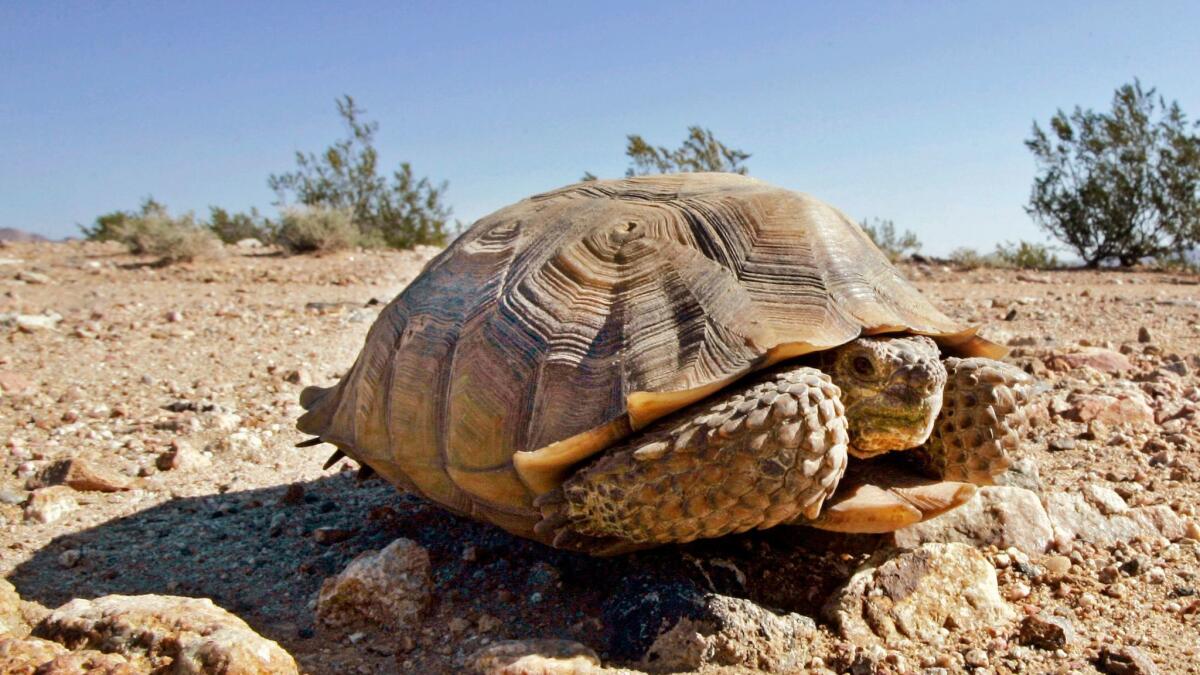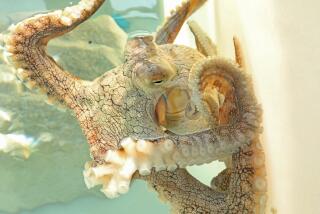Imperiled desert tortoises join California’s ‘endangered’ list... at least for now

The California Fish and Game Commission on Wednesday granted temporary endangered species status to the Mojave desert tortoise when it agreed to consider the dusty, armored herbivore as a candidate for permanent listing.
The protection came with the panel’s 4-0 decision to consider a petition filed by the Defenders of Wildlife, the Desert Tortoise Council, and the Desert Tortoise Preserve Committee. The groups argued that elevating the reptile’s existing status from threatened to endangered could bolster efforts to “reverse the very real likelihood that the desert tortoise will become extinct in California.”
As a candidate for listing, a species is typically afforded the same protections as a state endangered species pending a final decision.
While there is no difference in the protections offered a species listed as threatened or endangered under the California Endangered Species Act, officials said, endangered species have higher priority and funding for conservation measures such as habitat protection, recovery efforts and mitigation measures to reduce the impacts of projects.
“Anybody who has visited the Southern California desert over the past three decades knows this action is long overdue,” said Tom Egan, a biologist with Defenders of Wildlife. “What the state and federal governments have been doing to arrest their slide down the drain of extinction over the past three decades isn’t enough.”
The sun was rising over the Mojave Desert as crews prepared to demonstrate a devastating new weapon in the war among man, bird and reptile.
Gopherus agassizii was listed as threatened under state law in 1989 and under federal law the following year based on a severe decline in the tortoise population within their ancient desert kingdom of trails, arroyos and hibernation burrows fringed with scrub brush.
A recovery plan for the tortoise and critical habitat prepared by the U.S. Fish and Wildlife Service was adopted in 1994. That plan was revised in 2011, however, to correct problems that responsible wildlife and land management agencies were having in implementing the plan’s recovery strategies.
A 2018 study found that adult tortoise populations had plummeted by 50% in some designated recovery areas since 2004, and by as much as 90% in some critical habitat management units since the 1980s.
Tortoise populations continue to be irreversibly fragmented and destroyed by many causes: vehicles, shootings, urban encroachment, military maneuvers, mining, collecting, diseases introduced by pet tortoises released into the wild, development of massive utility and green-energy facilities and hungry ravens.
Unlike their heavily armored parents, baby desert tortoises are saddled with soft, fingernail-thin shells that biologists say make them easy pickings for predators and reduce the chances that the imperiled species can be saved from extinction.
Rising temperatures and drought conditions are also taking a toll on the desert tortoise. Despite its name, the reptile is not well adapted to desert conditions. It evolved tens of thousands of years ago, scientists say, when the landscape was dominated by lakes edged with Joshua trees and junipers.
Scientists believe that large numbers of female desert tortoise carcasses discovered near Joshua Tree National Park may have been trying to ward off extinction due to prolonged drought with a potentially lethal response: exhausting their water and energy to lay eggs.
Drought conditions also kill off nutritious foliage and trigger a crash in populations of rodents that eat them. As a result, dogs and coyotes, which normally thrive on kangaroo rats and rabbits, turn to the lumbering tortoises for sustenance, according to surveys by state and federal biologists.
“This species is already listed as threatened,” said Commission Vice President Samantha Murray before casting her vote. “But I do think it is important that its designation reflects reality.”







